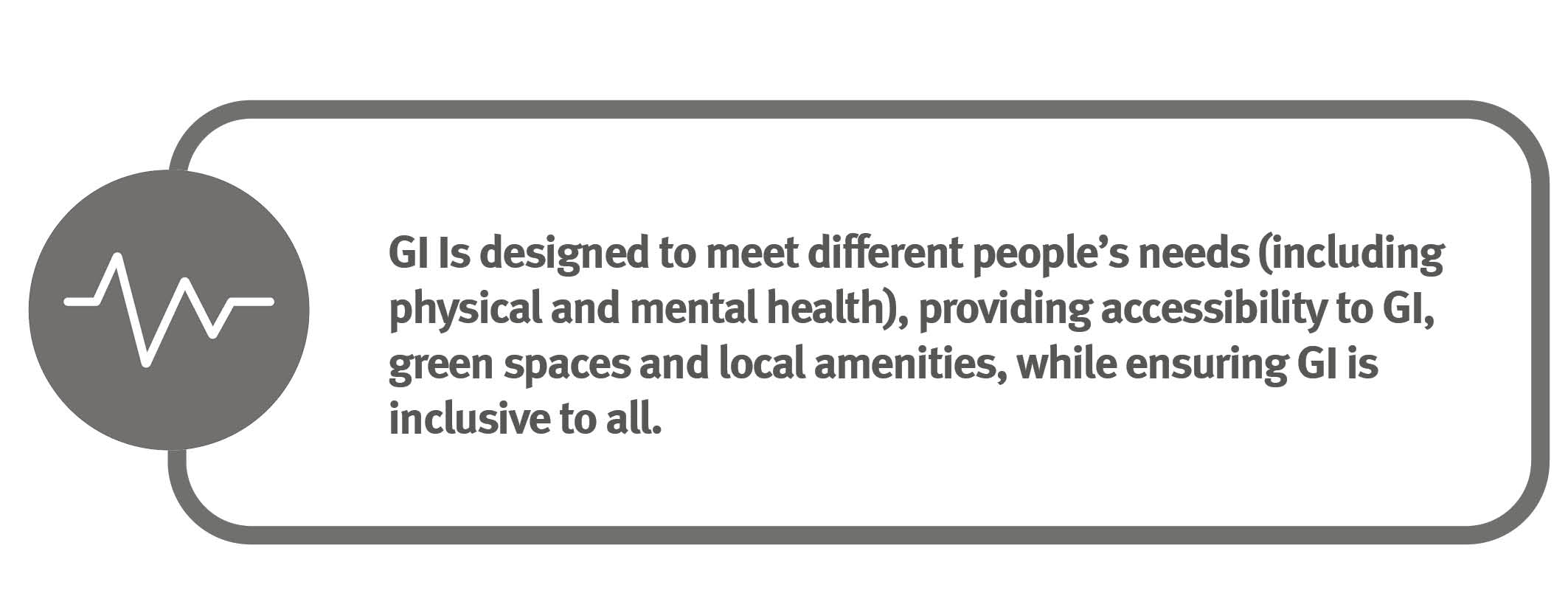Principle 6: Health, Wellbeing and Social Equity
Standard
Why does it matter?
Access to nature rich environments and green spaces can have a positive impact on health and wellbeing, encouraging more active lifestyles. There is a clear association between psychological health, mental wellbeing, and physical activity.
Recent studies during the Covid-19 pandemic have highlighted the key role that green spaces play for people’s health and wellbeing. But the current distribution and access to those spaces are not equitable. New developments might have access to green spaces, but existing developments in many deprived urban areas may not and urgently need reinvestment.
Meeting the principle
Policy requires connectivity between GI features and where people live and work, to optimise use and enjoyment. Good quality parks and green spaces need to be fully accessible to all and located near to where people live and provided at all scales, which will support a wide range of healthy activities. For example:
- Improving the connectivity to ensure there are good accessible links for all throughout neighbourhoods and urban and rural areas to green spaces.
- Public parks, playing fields, pathways, Public Rights of Way, multi-user routes (including bridleways), cycle paths and jogging tracks that encourage outdoor activity and promote good physical health.
- Urban vegetation, i.e.
- allotments, community gardens and orchards promoting healthy eating,
- trees, green roofs and private gardens that regulate air quality and reduce the ‘urban heat island’ effect.
- Wetlands, grassed areas and urban forests reduce the risk of flooding, sewage overflow and clean water contamination.
- Communal parks, village greens and town squares that enhance community attachment, social cohesion and a sense of environmental responsibility.
- Green spaces in a residential community attract tourism and investment and improve employment and income potential.
Where GI such as new cycle and pedestrian paths and green spaces are developed, care should be taken to ensure that safety is maintained. This will include amenities such as lighting, play equipment, benches, level paths, good signposting, and clear sightlines to be of good quality and be well maintained, without becoming potential areas for anti-social activity.
A Health Impact Assessment (HIA) will help to assess if the GI provision meets the diversity of user groups, whose needs may vary according to age, abilities, interest, or cultural beliefs. Policy supports targeted approaches in new development, or changes to existing settlements, to enhance areas that lack GI, have health inequalities and a high level of deprivation through requiring developments to complete a HIA. This includes access to natural play for younger and older children. You will need to ensure that areas with higher deprivation levels and lower access to green space are given the required attention. Other potential physical barriers for users that have an impact on health will also need addressing, such as vandalism, lighting, dog fouling, fly tipping and graffiti.
Policy requires new development to deliver GI features that incorporate existing landscape and historic features, whilst protecting or creating features that enhance views. Policy also requires new developments to provide the provision of and access to good quality parks and green spaces, that is accessible to all and located near to where people live. Policy ensures that provision is made to delivering GI and green spaces at all scales. That is made to support a wide range of healthy activities, such as sensory gardens, safe and attractive green routes, multi-user routes (including bridleways, cycle paths and jogging tracks) and accessible green spaces.
For that additional layer of quality assurance for policy and strategic documents Building with Nature could be used, which is a UK wide benchmark for GI, launched in 2018. Building with Nature offer a set of GI Standards, which can be downloaded for free from their website, plus a formal Accreditation scheme to help accredit policy. Building with Nature standards support and give credibility to the commitment to delivering and sustaining a flourishing place for people and wildlife.
Development proposals and projects should demonstrate how access and enjoyment of all users are integral to GI at each stage of delivery (design, implementation, management, and maintenance). They should contribute to community cohesion and wellbeing by providing a wide range of GI features that promote community-led activity to enable inclusive use of GI, that will provide health and wellbeing benefits.

Essex Green Infrastructure Standards Technical Guidance
Livewell Development Accreditation
Page updated: 4/04/2023
